Abstract
Bronchial provocation challenges with exercise and methacholine were performed on the same day or within a short interval in 52 children with asthma, 22 with other types of chronic lung disease (including cystic fibrosis), and 19 control subjects with no evidence of chronic lung disease. There were no significant differences in the baseline lung function before the two types of challenge in the individual groups and differences between the patients with asthma and with chronic lung disease were minor. When the mean -2 SD of the methacholine response of the control group was taken as the lower limit of normal, 49/52 (94%) patients with asthma and 18/22 (82%) with chronic lung disease responded abnormally. In contrast, with the mean +2 SD of the exercise response of the control group as the upper limit of normal, 41/52 (79%) asthmatic patients responded but none of those with chronic lung disease. Thus the response to the two types of challenge helps to distinguish asthma from other types of chronic lung disease in children.
Full text
PDF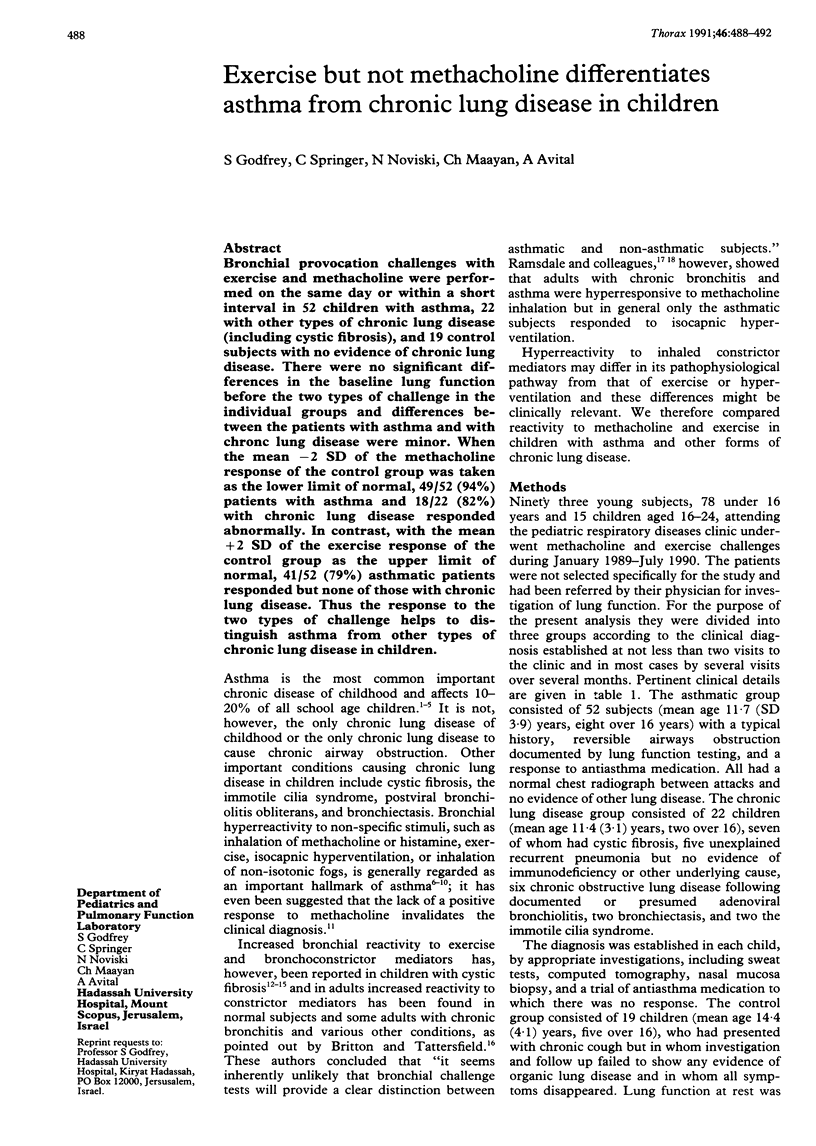
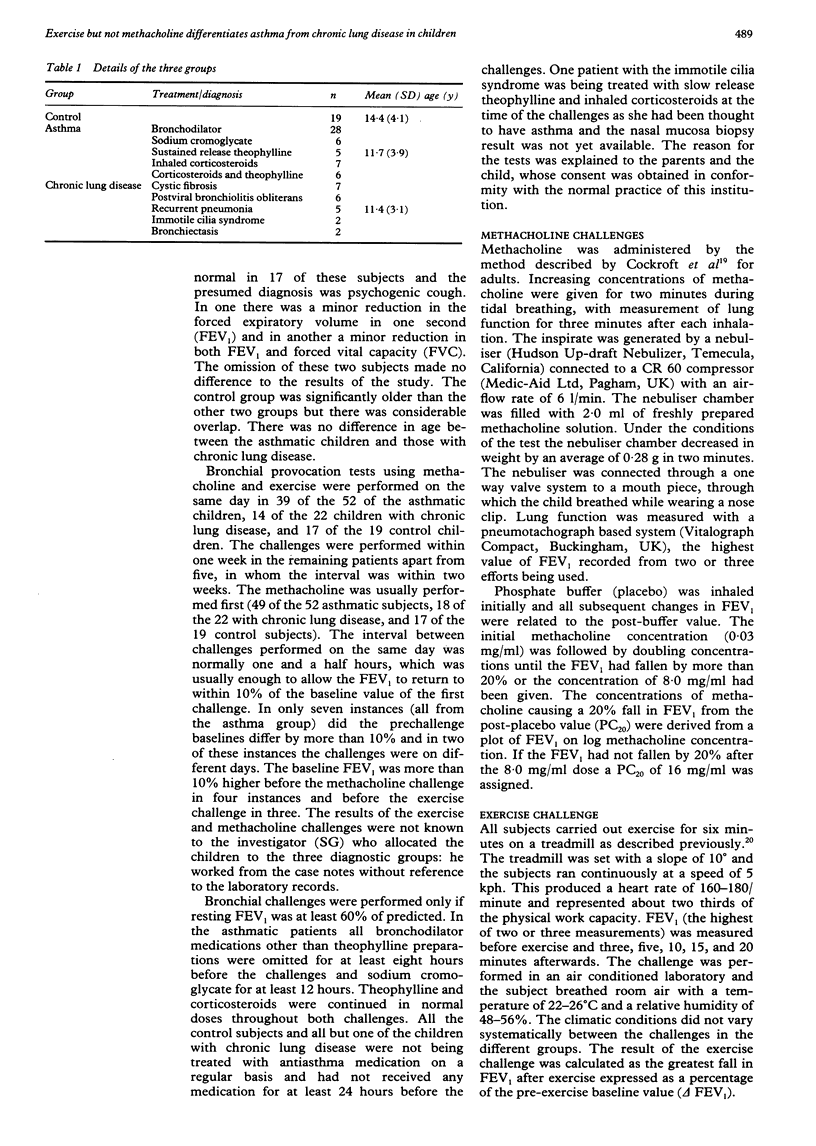
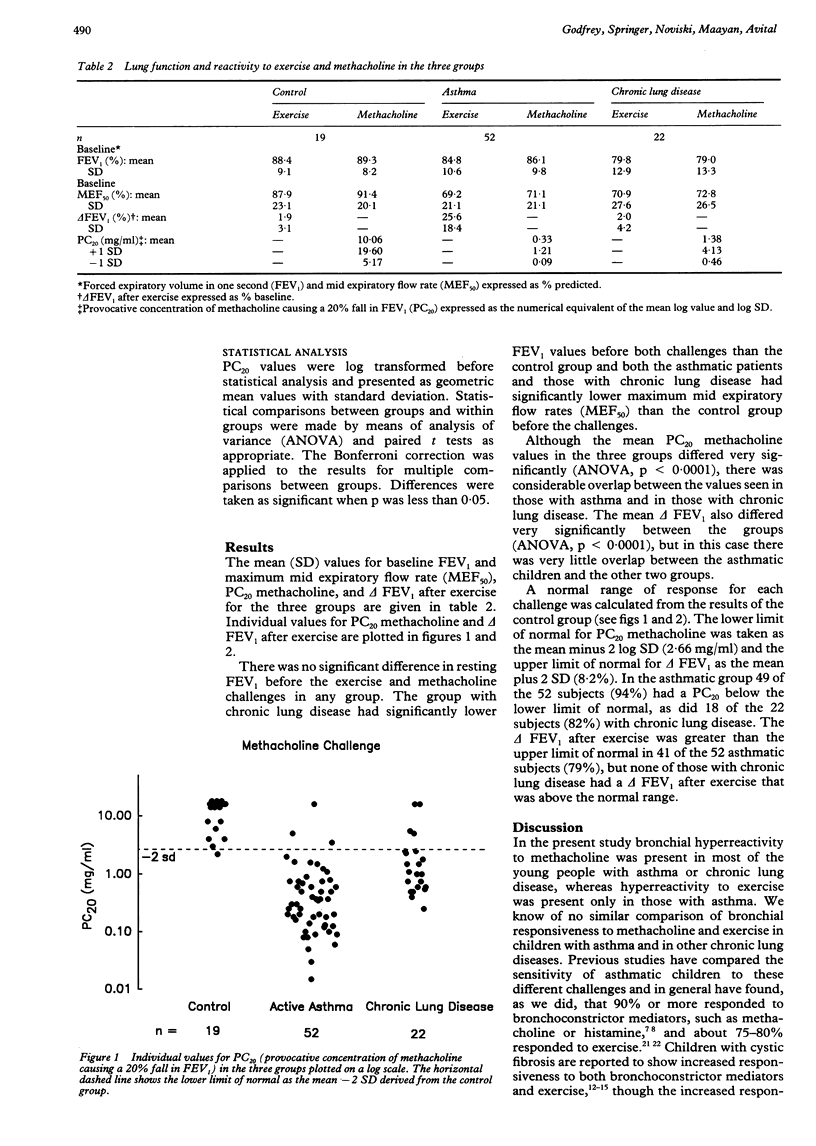
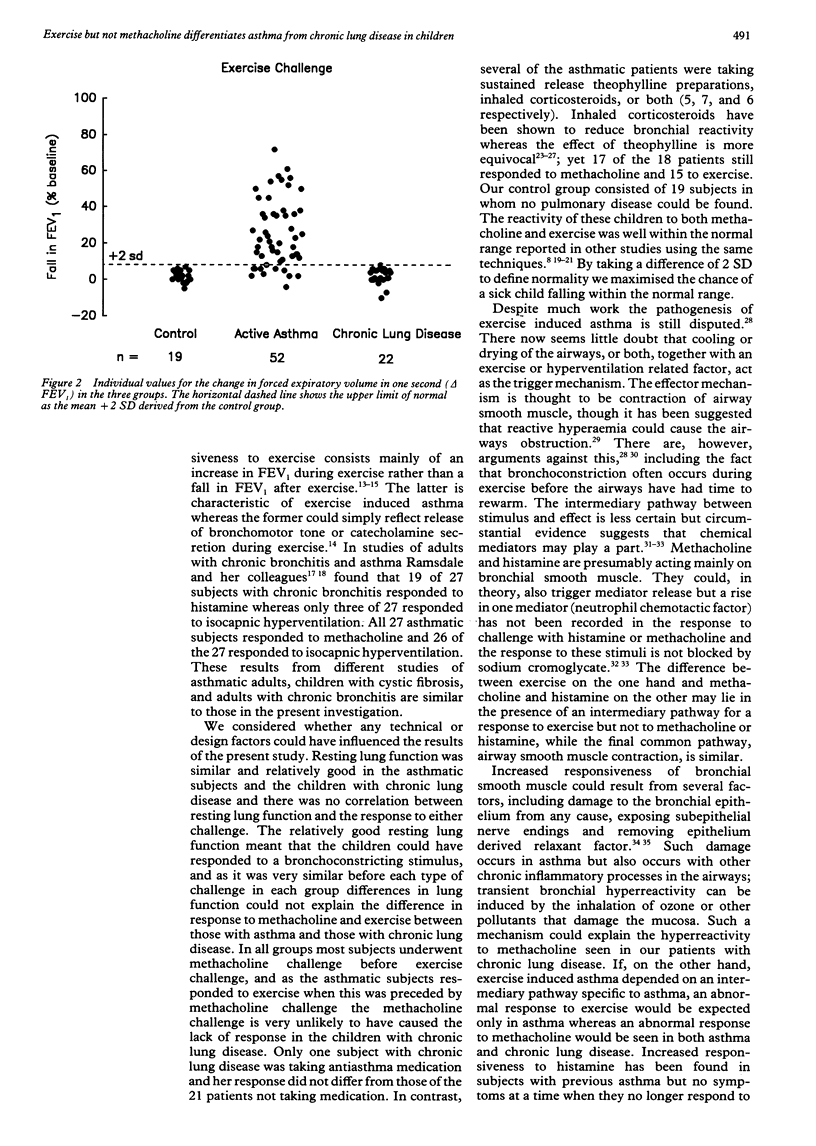
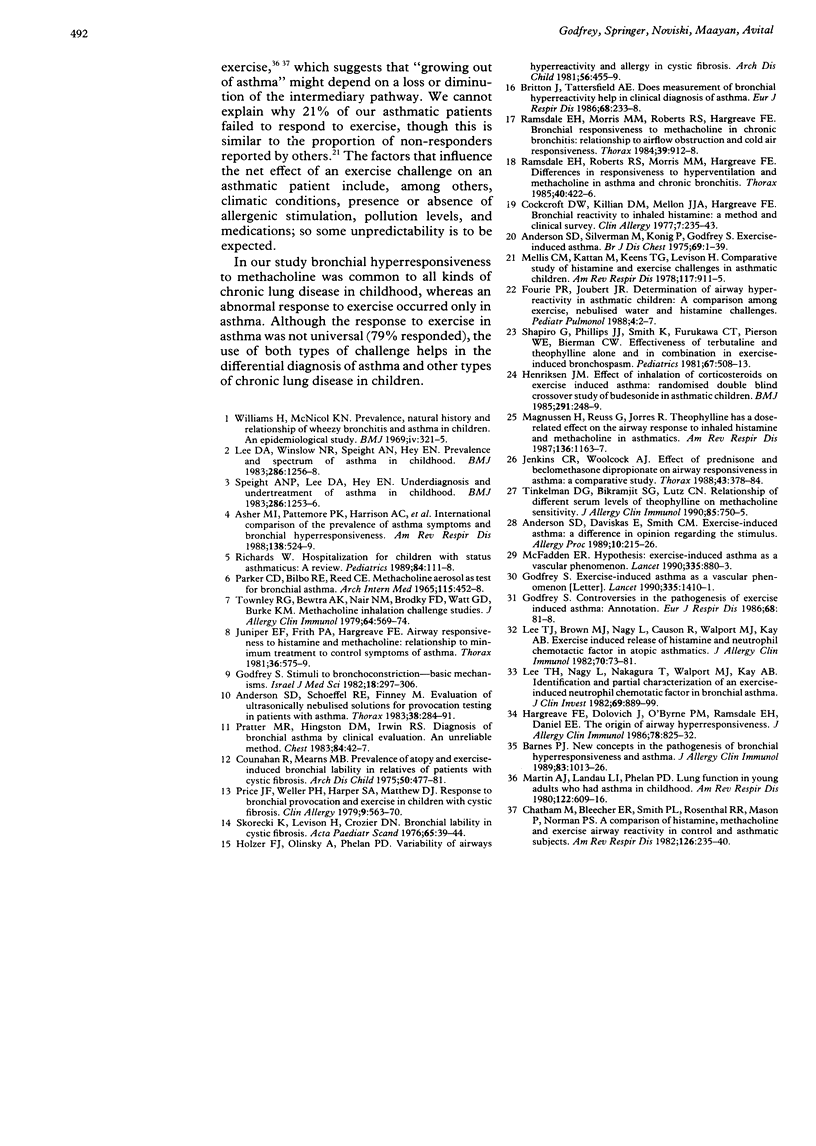
Selected References
These references are in PubMed. This may not be the complete list of references from this article.
- Anderson S. D., Daviskas E., Smith C. M. Exercise-induced asthma: a difference in opinion regarding the stimulus. Allergy Proc. 1989 May-Jun;10(3):215–226. doi: 10.2500/108854189778960054. [DOI] [PubMed] [Google Scholar]
- Anderson S. D., Schoeffel R. E., Finney M. Evaluation of ultrasonically nebulised solutions for provocation testing in patients with asthma. Thorax. 1983 Apr;38(4):284–291. doi: 10.1136/thx.38.4.284. [DOI] [PMC free article] [PubMed] [Google Scholar]
- Anderson S. D., Silverman M., König P., Godfrey S. Exercise-induced asthma. Br J Dis Chest. 1975 Jan;69(1):1–39. doi: 10.1016/0007-0971(75)90053-4. [DOI] [PubMed] [Google Scholar]
- Asher M. I., Pattemore P. K., Harrison A. C., Mitchell E. A., Rea H. H., Stewart A. W., Woolcock A. J. International comparison of the prevalence of asthma symptoms and bronchial hyperresponsiveness. Am Rev Respir Dis. 1988 Sep;138(3):524–529. doi: 10.1164/ajrccm/138.3.524. [DOI] [PubMed] [Google Scholar]
- Barnes P. J. New concepts in the pathogenesis of bronchial hyperresponsiveness and asthma. J Allergy Clin Immunol. 1989 Jun;83(6):1013–1026. doi: 10.1016/0091-6749(89)90441-7. [DOI] [PubMed] [Google Scholar]
- Britton J., Tattersfield A. E. Does measurement of bronchial hyperreactivity help in the clinical diagnosis of asthma? Eur J Respir Dis. 1986 Apr;68(4):233–238. [PubMed] [Google Scholar]
- Chatham M., Bleecker E. R., Smith P. L., Rosenthal R. R., Mason P., Norman P. S. A comparison of histamine, methacholine, and exercise airway reactivity in normal and asthmatic subjects. Am Rev Respir Dis. 1982 Aug;126(2):235–240. doi: 10.1164/arrd.1982.126.2.235. [DOI] [PubMed] [Google Scholar]
- Cochrane C. G. The enhancement of inflammatory injury. Am Rev Respir Dis. 1987 Jul;136(1):1–2. doi: 10.1164/ajrccm/136.1.1. [DOI] [PubMed] [Google Scholar]
- Cockcroft D. W., Killian D. N., Mellon J. J., Hargreave F. E. Bronchial reactivity to inhaled histamine: a method and clinical survey. Clin Allergy. 1977 May;7(3):235–243. doi: 10.1111/j.1365-2222.1977.tb01448.x. [DOI] [PubMed] [Google Scholar]
- Counahan R., Mearns M. B. Prevalence of atopy and exercise-induced bronchial lability in relatives of patients with cystic fibrosis. Arch Dis Child. 1975 Jun;50(6):477–481. doi: 10.1136/adc.50.6.477. [DOI] [PMC free article] [PubMed] [Google Scholar]
- Exercise-induced asthma as a vascular phenomenon. Lancet. 1990 Jun 9;335(8702):1410–1412. [PubMed] [Google Scholar]
- Fourie P. R., Joubert J. R. Determination of airway hyper-reactivity in asthmatic children: a comparison among exercise, nebulized water, and histamine challenge. Pediatr Pulmonol. 1988 Jan-Feb;4(1):2–7. doi: 10.1002/ppul.1950040103. [DOI] [PubMed] [Google Scholar]
- Godfrey S. Controversies in the pathogenesis of exercise-induced asthma. Eur J Respir Dis. 1986 Feb;68(2):81–88. [PubMed] [Google Scholar]
- Godfrey S. Stimuli to bronchoconstriction: basic mechanisms. Isr J Med Sci. 1982 Feb;18(2):297–306. [PubMed] [Google Scholar]
- Hargreave F. E., Dolovich J., O'Byrne P. M., Ramsdale E. H., Daniel E. E. The origin of airway hyperresponsiveness. J Allergy Clin Immunol. 1986 Nov;78(5 Pt 1):825–832. doi: 10.1016/0091-6749(86)90226-5. [DOI] [PubMed] [Google Scholar]
- Henriksen J. M. Effect of inhalation of corticosteroids on exercise induced asthma: randomised double blind crossover study of budesonide in asthmatic children. Br Med J (Clin Res Ed) 1985 Jul 27;291(6490):248–249. doi: 10.1136/bmj.291.6490.248-a. [DOI] [PMC free article] [PubMed] [Google Scholar]
- Holzer F. J., Olinsky A., Phelan P. D. Variability of airways hyper-reactivity and allergy in cystic fibrosis. Arch Dis Child. 1981 Jun;56(6):455–459. doi: 10.1136/adc.56.6.455. [DOI] [PMC free article] [PubMed] [Google Scholar]
- Jenkins C. R., Woolcock A. J. Effect of prednisone and beclomethasone dipropionate on airway responsiveness in asthma: a comparative study. Thorax. 1988 May;43(5):378–384. doi: 10.1136/thx.43.5.378. [DOI] [PMC free article] [PubMed] [Google Scholar]
- Juniper E. F., Frith P. A., Hargreave F. E. Airway responsiveness to histamine and methacholine: relationship to minimum treatment to control symptoms of asthma. Thorax. 1981 Aug;36(8):575–579. doi: 10.1136/thx.36.8.575. [DOI] [PMC free article] [PubMed] [Google Scholar]
- Lee D. A., Winslow N. R., Speight A. N., Hey E. N. Prevalence and spectrum of asthma in childhood. Br Med J (Clin Res Ed) 1983 Apr 16;286(6373):1256–1258. doi: 10.1136/bmj.286.6373.1256. [DOI] [PMC free article] [PubMed] [Google Scholar]
- Lee T. H., Brown M. J., Nagy L., Causon R., Walport M. J., Kay A. B. Exercise-induced release of histamine and neutrophil chemotactic factor in atopic asthmatics. J Allergy Clin Immunol. 1982 Aug;70(2):73–81. doi: 10.1016/0091-6749(82)90232-9. [DOI] [PubMed] [Google Scholar]
- Lee T. H., Nagy L., Nagakura T., Walport M. J., Kay A. B. Identification and partial characterization of an exercise-induced neutrophil chemotactic factor in bronchial asthma. J Clin Invest. 1982 Apr;69(4):889–899. doi: 10.1172/JCI110528. [DOI] [PMC free article] [PubMed] [Google Scholar]
- Martin A. J., Landau L. I., Phelan P. D. Lung function in young adults who had asthma in childhood. Am Rev Respir Dis. 1980 Oct;122(4):609–616. doi: 10.1164/arrd.1980.122.4.609. [DOI] [PubMed] [Google Scholar]
- McFadden E. R., Jr Hypothesis: exercise-induced asthma as a vascular phenomenon. Lancet. 1990 Apr 14;335(8694):880–883. doi: 10.1016/0140-6736(90)90478-n. [DOI] [PubMed] [Google Scholar]
- Mellis C. M., Kattan M., Keens T. G., Levison H. Comparative study of histamine and exercise challenges in asthmatic children. Am Rev Respir Dis. 1978 May;117(5):911–915. doi: 10.1164/arrd.1978.117.5.911. [DOI] [PubMed] [Google Scholar]
- PARKER C. D., BILBO R. E., REED C. E. METHACHOLINE AEROSOL AS TEST FOR BRONCHIAL ASTHMA. Arch Intern Med. 1965 Apr;115:452–458. doi: 10.1001/archinte.1965.03860160078013. [DOI] [PubMed] [Google Scholar]
- Pratter M. R., Hingston D. M., Irwin R. S. Diagnosis of bronchial asthma by clinical evaluation. An unreliable method. Chest. 1983 Jul;84(1):42–47. doi: 10.1378/chest.84.1.42. [DOI] [PubMed] [Google Scholar]
- Price J. F., Weller P. H., Harper S. A., Matthew D. J. Response to bronchial provocation and exercise in children with cystic fibrosis. Clin Allergy. 1979 Nov;9(6):563–570. doi: 10.1111/j.1365-2222.1979.tb00480.x. [DOI] [PubMed] [Google Scholar]
- Ramsdale E. H., Morris M. M., Roberts R. S., Hargreave F. E. Bronchial responsiveness to methacholine in chronic bronchitis: relationship to airflow obstruction and cold air responsiveness. Thorax. 1984 Dec;39(12):912–918. doi: 10.1136/thx.39.12.912. [DOI] [PMC free article] [PubMed] [Google Scholar]
- Ramsdale E. H., Roberts R. S., Morris M. M., Hargreave F. E. Differences in responsiveness to hyperventilation and methacholine in asthma and chronic bronchitis. Thorax. 1985 Jun;40(6):422–426. doi: 10.1136/thx.40.6.422. [DOI] [PMC free article] [PubMed] [Google Scholar]
- Richards W. Hospitalization of children with status asthmaticus: a review. Pediatrics. 1989 Jul;84(1):111–118. [PubMed] [Google Scholar]
- Shapiro G. G., McPhillips J. J., Smith K., Furukawa C. T., Pierson W. E., Bierman C. W. Effectiveness of terbutaline and theophylline alone and in combination in exercise-induced bronchospasm. Pediatrics. 1981 Apr;67(4):508–513. [PubMed] [Google Scholar]
- Skorecki K., Levison H., Crozier D. N. Bronchial lability in cystic fibrosis. Acta Paediatr Scand. 1976 Jan;65(1):39–44. doi: 10.1111/j.1651-2227.1976.tb04405.x. [DOI] [PubMed] [Google Scholar]
- Speight A. N., Lee D. A., Hey E. N. Underdiagnosis and undertreatment of asthma in childhood. Br Med J (Clin Res Ed) 1983 Apr 16;286(6373):1253–1256. doi: 10.1136/bmj.286.6373.1253. [DOI] [PMC free article] [PubMed] [Google Scholar]
- Tinkelman D. G., Garcha B. S., Lutz C. N. Relationship of different serum levels of theophylline on methacholine sensitivity. J Allergy Clin Immunol. 1990 Apr;85(4):750–755. doi: 10.1016/0091-6749(90)90194-9. [DOI] [PubMed] [Google Scholar]
- Townley R. G., Bewtra A. K., Nair N. M., Brodkey F. D., Watt G. D., Burke K. M. Methacholine inhalation challenge studies. J Allergy Clin Immunol. 1979 Dec;64(6 Pt 2):569–574. doi: 10.1016/0091-6749(79)90014-9. [DOI] [PubMed] [Google Scholar]
- Williams H., McNicol K. N. Prevalence, natural history, and relationship of wheezy bronchitis and asthma in children. An epidemiological study. Br Med J. 1969 Nov 8;4(5679):321–325. doi: 10.1136/bmj.4.5679.321. [DOI] [PMC free article] [PubMed] [Google Scholar]


